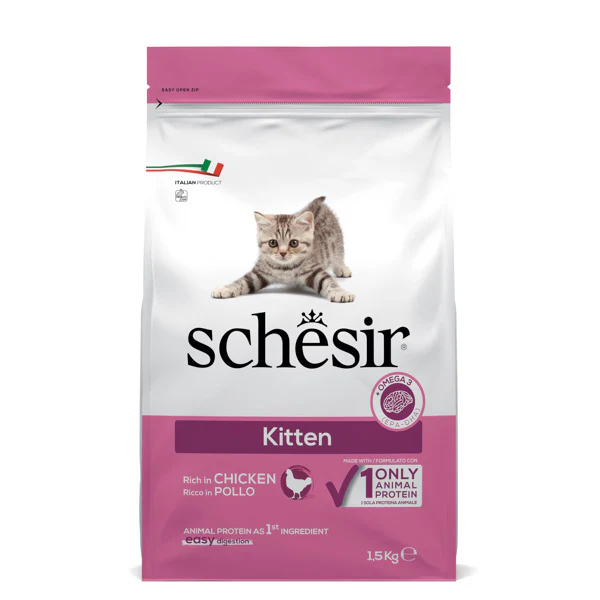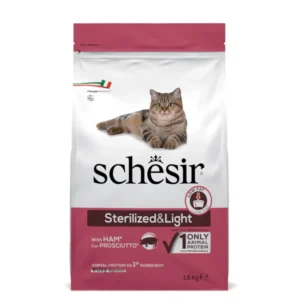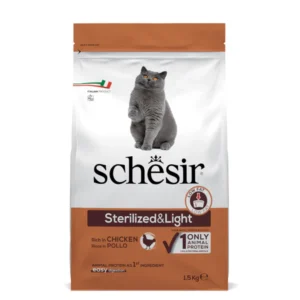Schesir
Kitten Rich in Chicken
Kitten
Regular
Indoor and Outdoor
Click to reveal the score breakdown
Tap to view ingredients, guaranteed analysis and more
Product Summary
Schesir: Kitten Rich in Chicken is a dry food designed to meet the nutritional needs of growing kittens. With 34% protein and 19% fat, it supports healthy development, muscle growth, and energy levels. Chicken is the primary protein source, promoting digestibility and quality nutrition. Additionally, it contains Omega-3 fatty acids like DHA and EPA, which contribute to brain and eye development and are particularly useful for kittens and pregnant or nursing cats.
Pros:
- High-quality 34% crude protein primarily from chicken, supporting muscle growth.
- Enriched with Omega-3 fatty acids (0.11% DHA, 0.11% EPA) for brain and vision development.
- It contains biotin and brewer’s yeast to promote healthy skin and fur.
Cons:
- 19% fat may be higher than ideal for less active kittens, potentially leading to excess weight.
- Carbohydrate content isn’t specified, which may concern pet owners monitoring carb intake.
- 2.8% crude fiber is relatively low for optimal digestive support.
Ingredients
Dehydrated chicken proteins
26%
Rice
Pork fat
Barley
Corn gluten
Potato proteins
Dried beet pulp
Fish oil
Egg powder
Linseed
and also:
1% chicory pulp, 1% brewer's yeast , 0.6% fructooligosaccharides (FOS), pea flour, vegetable fibres, potassium chloride, 0.1% yucca schidigera
Vitamins and Additives
Vitamin A 31000 IU
Vitamin B1 7.5 mg/kg
Vitamin B2 0.003 mg/kg
Vitamin B6 4 mg/kg
Vitamin B12 0.003 mg/kg
Vitamin C 200 mg/kg
Vitamin D3 1600 IU
Vitamin E 300 mg/kg
and also:
Niacin 42.5 mg/kg, Folic acid 1 mg/kg, Calcium D-pantothenate 8 mg/kg, Biotin 0.1 mg/kg, Taurine 2,500 mg/kg, DL-Methionine 1,000 mg/kg, iron 107 mg/kg (iron (II) sulphate monohydrate), copper 10 mg/kg (copper (II) sulphate pentahydrate), manganese 10 mg/kg (manganous sulphate monohydrate), zinc 102 mg/kg (zinc sulphate monohydrate), iodine 1.8 mg/kg (anhydrous calcium iodate), selenium 0.3 mg/kg (sodium selenite). Technological additives: antioxidants Organoleptic additives: flavorings (mixture of extracts of rosemary, turmeric, citrus fruits and clove oil 300 mg/kg)
Guaranteed Analysis
Crude Protein
34%
Crude Fat
19%
Crude Fiber
2.8%
Moisture
10%
Crude Ash
5.9%
Calcium
0.95%
Phosphorus
0.85%
Potassium
0.6%
Magnesium
0.07%
Omega 3
0.45%
Omega 6
2.2%
Metabolizable Energy
3870 kcal/kg
Product last updated: September 27, 2024, 4:21 PM
Please hold on while we’re getting the best offers for you
7508







